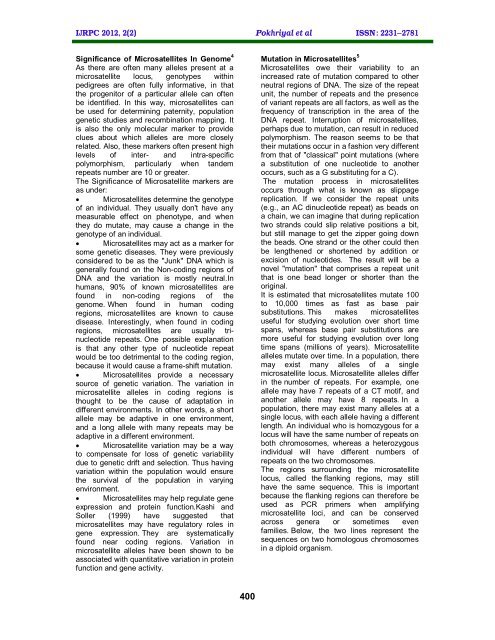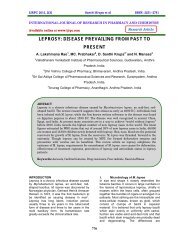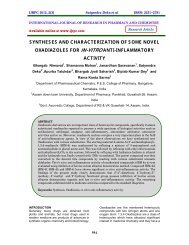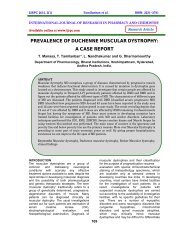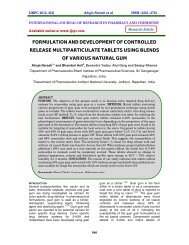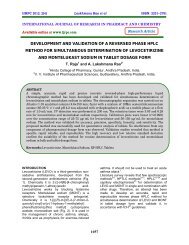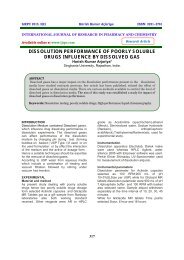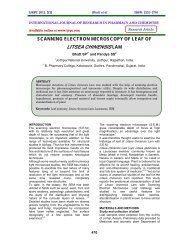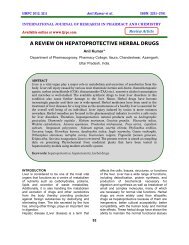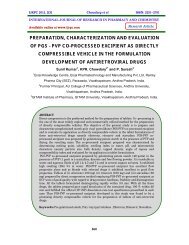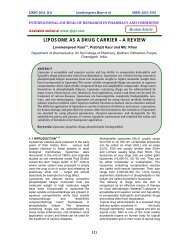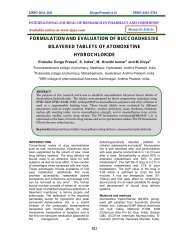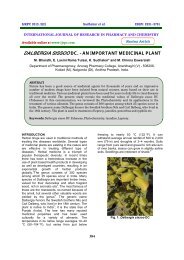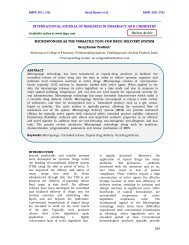microsatellite markers – a novel tool in molecular genetics - ijrpc
microsatellite markers – a novel tool in molecular genetics - ijrpc
microsatellite markers – a novel tool in molecular genetics - ijrpc
Create successful ePaper yourself
Turn your PDF publications into a flip-book with our unique Google optimized e-Paper software.
IJRPC 2012, 2(2) Pokhriyal et al ISSN: 22312781<br />
Significance of Microsatellites In Genome 4<br />
As there are often many alleles present at a<br />
<strong>microsatellite</strong> locus, genotypes with<strong>in</strong><br />
pedigrees are often fully <strong>in</strong>formative, <strong>in</strong> that<br />
the progenitor of a particular allele can often<br />
be identified. In this way, <strong>microsatellite</strong>s can<br />
be used for determ<strong>in</strong><strong>in</strong>g paternity, population<br />
genetic studies and recomb<strong>in</strong>ation mapp<strong>in</strong>g. It<br />
is also the only <strong>molecular</strong> marker to provide<br />
clues about which alleles are more closely<br />
related. Also, these <strong>markers</strong> often present high<br />
levels of <strong>in</strong>ter- and <strong>in</strong>tra-specific<br />
polymorphism, particularly when tandem<br />
repeats number are 10 or greater.<br />
The Significance of Microsatellite <strong>markers</strong> are<br />
as under:<br />
Microsatellites determ<strong>in</strong>e the genotype<br />
of an <strong>in</strong>dividual. They usually don't have any<br />
measurable effect on phenotype, and when<br />
they do mutate, may cause a change <strong>in</strong> the<br />
genotype of an <strong>in</strong>dividual.<br />
Microsatellites may act as a marker for<br />
some genetic diseases. They were previously<br />
considered to be as the "Junk" DNA which is<br />
generally found on the Non-cod<strong>in</strong>g regions of<br />
DNA and the variation is mostly neutral.In<br />
humans, 90% of known <strong>microsatellite</strong>s are<br />
found <strong>in</strong> non-cod<strong>in</strong>g regions of the<br />
genome. When found <strong>in</strong> human cod<strong>in</strong>g<br />
regions, <strong>microsatellite</strong>s are known to cause<br />
disease. Interest<strong>in</strong>gly, when found <strong>in</strong> cod<strong>in</strong>g<br />
regions, <strong>microsatellite</strong>s are usually tr<strong>in</strong>ucleotide<br />
repeats. One possible explanation<br />
is that any other type of nucleotide repeat<br />
would be too detrimental to the cod<strong>in</strong>g region,<br />
because it would cause a frame-shift mutation.<br />
Microsatellites provide a necessary<br />
source of genetic variation. The variation <strong>in</strong><br />
<strong>microsatellite</strong> alleles <strong>in</strong> cod<strong>in</strong>g regions is<br />
thought to be the cause of adaptation <strong>in</strong><br />
different environments. In other words, a short<br />
allele may be adaptive <strong>in</strong> one environment,<br />
and a long allele with many repeats may be<br />
adaptive <strong>in</strong> a different environment.<br />
Microsatellite variation may be a way<br />
to compensate for loss of genetic variability<br />
due to genetic drift and selection. Thus hav<strong>in</strong>g<br />
variation with<strong>in</strong> the population would ensure<br />
the survival of the population <strong>in</strong> vary<strong>in</strong>g<br />
environment.<br />
Microsatellites may help regulate gene<br />
expression and prote<strong>in</strong> function.Kashi and<br />
Soller (1999) have suggested that<br />
<strong>microsatellite</strong>s may have regulatory roles <strong>in</strong><br />
gene expression. They are systematically<br />
found near cod<strong>in</strong>g regions. Variation <strong>in</strong><br />
<strong>microsatellite</strong> alleles have been shown to be<br />
associated with quantitative variation <strong>in</strong> prote<strong>in</strong><br />
function and gene activity.<br />
Mutation <strong>in</strong> Microsatellites 5<br />
Microsatellites owe their variability to an<br />
<strong>in</strong>creased rate of mutation compared to other<br />
neutral regions of DNA. The size of the repeat<br />
unit, the number of repeats and the presence<br />
of variant repeats are all factors, as well as the<br />
frequency of transcription <strong>in</strong> the area of the<br />
DNA repeat. Interruption of <strong>microsatellite</strong>s,<br />
perhaps due to mutation, can result <strong>in</strong> reduced<br />
polymorphism. The reason seems to be that<br />
their mutations occur <strong>in</strong> a fashion very different<br />
from that of "classical" po<strong>in</strong>t mutations (where<br />
a substitution of one nucleotide to another<br />
occurs, such as a G substitut<strong>in</strong>g for a C).<br />
The mutation process <strong>in</strong> <strong>microsatellite</strong>s<br />
occurs through what is known as slippage<br />
replication. If we consider the repeat units<br />
(e.g., an AC d<strong>in</strong>ucleotide repeat) as beads on<br />
a cha<strong>in</strong>, we can imag<strong>in</strong>e that dur<strong>in</strong>g replication<br />
two strands could slip relative positions a bit,<br />
but still manage to get the zipper go<strong>in</strong>g down<br />
the beads. One strand or the other could then<br />
be lengthened or shortened by addition or<br />
excision of nucleotides. The result will be a<br />
<strong>novel</strong> "mutation" that comprises a repeat unit<br />
that is one bead longer or shorter than the<br />
orig<strong>in</strong>al.<br />
It is estimated that <strong>microsatellite</strong>s mutate 100<br />
to 10,000 times as fast as base pair<br />
substitutions. This makes <strong>microsatellite</strong>s<br />
useful for study<strong>in</strong>g evolution over short time<br />
spans, whereas base pair substitutions are<br />
more useful for study<strong>in</strong>g evolution over long<br />
time spans (millions of years). Microsatellite<br />
alleles mutate over time. In a population, there<br />
may exist many alleles of a s<strong>in</strong>gle<br />
<strong>microsatellite</strong> locus. Microsatellite alleles differ<br />
<strong>in</strong> the number of repeats. For example, one<br />
allele may have 7 repeats of a CT motif, and<br />
another allele may have 8 repeats. In a<br />
population, there may exist many alleles at a<br />
s<strong>in</strong>gle locus, with each allele hav<strong>in</strong>g a different<br />
length. An <strong>in</strong>dividual who is homozygous for a<br />
locus will have the same number of repeats on<br />
both chromosomes, whereas a heterozygous<br />
<strong>in</strong>dividual will have different numbers of<br />
repeats on the two chromosomes.<br />
The regions surround<strong>in</strong>g the <strong>microsatellite</strong><br />
locus, called the flank<strong>in</strong>g regions, may still<br />
have the same sequence. This is important<br />
because the flank<strong>in</strong>g regions can therefore be<br />
used as PCR primers when amplify<strong>in</strong>g<br />
<strong>microsatellite</strong> loci, and can be conserved<br />
across genera or sometimes even<br />
families. Below, the two l<strong>in</strong>es represent the<br />
sequences on two homologous chromosomes<br />
<strong>in</strong> a diploid organism.<br />
400


